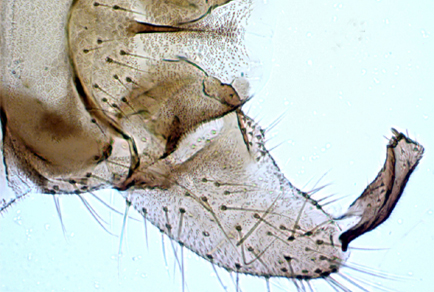Abstract
The adult male, pupa, larva with DNA barcoding of Ps. matafonovi sp. nov. and the adult male of Ps. silinka sp. nov. from Amur River basin of Russia are described and illustrated. Ps. matafonovi sp. nov. is genetically distant from other Pseudokiefferiella showing uncorrected p-distances of >6.8 %. The results of species delimitation show that genus Pseudokiefferiella includes 10 (mPTP), 13 (ASAP, GMYC) or 14 (BOLD) distinct molecular taxonomic units (mOTUs) that requires a revision of this genus using both morphological and molecular approaches.
References
- Ashe, P. & O’Connor, J.P. (2009) A World Catalogue of Chironomidae (Diptera). Part 1. Buchonomyiinae, Chilenomyiinae, Podonominae, Aphroteniinae, Tanypodinae, Usambaromyiinae, Diamesinae, Prodiamesinae and Telmatogetoninae. Irish Biogeographical Society & National Museum of Ireland, Dublin, 445 pp.
- Edwards, F.W. (1932) Notes on Highland Diptera, with descriptions of six new species. Scottish Naturalist, 194, 43–52.
- Felsenstein, J. (1981) Evolutionary trees from DNA sequences: a maximum likelihood approach. Journal of Molecular Evolution, 17, 368–376. https://doi.org/10.1007/BF01734359
- Hansen, D.C. & Cook, E.F. (1976) The systematics and morphology of the Nearctic species of Diamesa Meigen, 1835 (Diptera: Chironomidae). Memoirs of the American Entomological Society, 30, 1–203.
- Kumar, S., Stecher, G. & Tamura, K. (2016) MEGA7: Molecular Evolutionary Genetics Analysis version 7.0 for bigger datasets. Molecular Biology and Evolution, 33 (7), 1870–1874. https://doi.org/10.1093/molbev/msw054
- Lanfear, R., Calcott, B., Ho, S.Y. & Guindon, S. (2012) Partitionfinder: combined selection of partitioning schemes and substitution models for phylogenetic analyses. Molecular Biology and Evolution, 29 (6), 1695–1701. https://doi.org/10.1093/molbev/mss020
- Makarchenko, E.A., Semenchenko, A.A. & Palatov, D.M. (2022) Taxonomy of Diamesa steinboecki group (Diptera: Chironomidae: Diamesinae), with description and DNA barcoding of new species. I. Subgroups steinboecki and longipes. Zootaxa, 5125 (5), 483–512. https://doi.org/10.11646/zootaxa.5125.5.2
- Makarchenko, E.A., Semenchenko, A.A. & Palatov, D.M. (2023) Fauna and taxonomy of Diamesinae (Diptera, Chironomidae) from the Caucasus, with a morphological description and DNA barcoding of new taxa and a discussion of diagnostic problems for Diamesa Meigen and Pseudodiamesa Goetghebuer. Zootaxa, 5271 (2), 313–328. https://doi.org/10.11646/zootaxa.5271.2.6
- Oliver, D.R. (1959) Some Diamesini (Chironomidae) from the Nearctic and Palaearctic. Entomologisk Tidskrift, 80, 48–64.
- Oliver, D.R. (1989) The adult males of Diamesinae (Diptera: Chironomidae) of the Holarctic region—Keys and diagnoses. Entomologica Scandinavica Supplement, 34 , 129–154.
- Pagast, F. (1947) Systematik und Verbreitung der um die Gattung Diamesa gruppierten Chironomiden. Archiv für Hydrobiologie, 41, 435–596.
- Pankratova, V.Ya. (1970) Larvae and pupae of the midges of the subfamily Orthocladiinae (Diptera, Chironomidae = Tendipedidae) of the USSR fauna. In: Key to the USSR fauna, published by Zoological Institute of the USSR Academy of Sciences. Vol. 102. Nauka, Leningrad, pp. 1–344. [in Russian]
- Rambaut, A., Drummond, A.J., Xie, D., Baele, G. & Suchard, M.A. (2018) Posterior summarisation in Bayesian phylogenetics using Tracer 1.7. Systematic Biology, 67 (5), 901–904. https://doi.org/10.1093/sysbio/syy032
- Ronquist, F., Teslenko, M., Mark, P.V.D., Ayres, D.L., Darling, A., Höhna, S., Larget, B., Liu, L., Suchard, M.A. & Huelsenbeck, J.P. (2012) MrBayes 3.2: Efficient Bayesian Phylogenetic Inference and Model Choice Across a Large Model Space. Systematic Biology, 61, 539–542. https://doi.org/10.1093/sysbio/sys029
- Sæther, O.A. (1980) Glossary of chironomid morphology terminology (Diptera: Chironomidae). Entomologica scandinavica, Supplement 14, 1–51.
- Schmid, P.E. (1993) A key to the larval Chironomidae and their instars from Austrian Danube region streams and rivers with particular reference to a numerical taxonomic approach. Part I. Diamesinae, Prodiamesinae and Orthocladiinae. Wasser und Abwasser, Supplementband 3/93, 1–514.
- Serra-Tosio, B. (1971) Contribution à l’étude taxonomique, phylogénétique, biogéographique et écologique des Diamesini (Diptera, Chironomidae) d’Europe. Doct. Thesis, A l’Université Scientifique et Médicale de Grenoble. Vols. I & II. pp. 2A-2E + 1–303 & pp. 304–462 + [1], pls. 1–184.
- Stur, E. & Ekrem, T. (2020) The Chironomidae (Diptera) of Svalbard and Jan Mayen. Insects, 11 (3, Paper 183), 1–103. https://doi.org/10.3390/insects11030183
- Tavaré, S. (1986) Some probabilistic and statistical problems in the analysis of DNA sequences. Lectures on Mathematics in the Life Sciences. American Mathematical Society, 17, 57–86.
- Wülker, W. (1959) Diamesarien-Studien (Diptera, Chironomidae) im Hochschwarzwald. Archiv für Hydrobiologie, 24, 338–360.
- Zavřel, J. (1941) Chironomidarum larvae et nymphae III. („Pseudokiefferiella“). Entomologické Listy. Folia Entomologica, 4, 9–14.
- Zharkikh, A.J. (1994) Estimation of evolutionary distances between nucleotide sequences. Molecular Evolution, 39 (3), 315– 329. https://doi.org/10.1007/BF00160155


